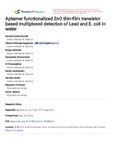Aptamer Functionalized ZnO Thin-Film Transistor Based Multiplexed Detection of Pb and E. Coli in Water<sup />
| dc.contributor.author | Honnali, SK | |
| dc.contributor.author | Srinivasa Raghavan, V | |
| dc.contributor.author | Ashwath, R | |
| dc.contributor.author | Saravanavel, G | |
| dc.contributor.author | Gunasekhar, KR | |
| dc.contributor.author | Sambandan, S | |
| dc.contributor.author | Gorthi, SS | |
| dc.contributor.author | O'Driscoll, Benjamin | |
| dc.contributor.author | Jenkins, David | |
| dc.date.accessioned | 2023-02-28T13:05:25Z | |
| dc.date.available | 2023-02-28T13:05:25Z | |
| dc.date.issued | 2022-09-23 | |
| dc.identifier.issn | 1530-437X | |
| dc.identifier.issn | 1558-1748 | |
| dc.identifier.uri | http://hdl.handle.net/10026.1/20505 | |
| dc.description.abstract |
In this work, we demonstrate the multiplexed detection platform to sense lead (Pb2+) and Escherichia coli in water using zinc oxide (ZnO) thin-film transistors (TFTs). Low-voltage ZnO TFTs fabricated by physical vapor deposition were functionalized with (3-Aminopropyl)triethoxysilane (APTES)-glutaraldehyde (GLU) molecules. TFTs with such functionalized ZnO surfaces showed good sensitivity and high specificity to the targets with a detection limit of 27 nM and 105 colony forming unit per mL (cfu/mL) for Pb2+ and E. coli, respectively, with the TFT flat-band voltage (Vfb) and, hence, the TFT transconductance, being dependent on the target concentration. The direct integration of the sensing with the TFT and associated integrated circuits promises high-density sensor arrays. | |
| dc.format.extent | 21209-21217 | |
| dc.language.iso | en | |
| dc.publisher | Institute of Electrical and Electronics Engineers (IEEE) | |
| dc.subject | Aptamer | |
| dc.subject | Escherichia coli | |
| dc.subject | Pb2+ | |
| dc.subject | thin-film transistor (TFT) array | |
| dc.subject | zinc oxide (ZnO) | |
| dc.title | Aptamer Functionalized ZnO Thin-Film Transistor Based Multiplexed Detection of Pb and E. Coli in Water<sup /> | |
| dc.type | journal-article | |
| dc.type | Journal Article | |
| plymouth.author-url | https://www.webofscience.com/api/gateway?GWVersion=2&SrcApp=PARTNER_APP&SrcAuth=LinksAMR&KeyUT=WOS:000878266500118&DestLinkType=FullRecord&DestApp=ALL_WOS&UsrCustomerID=11bb513d99f797142bcfeffcc58ea008 | |
| plymouth.issue | 21 | |
| plymouth.volume | 22 | |
| plymouth.publication-status | Published | |
| plymouth.journal | IEEE Sensors Journal | |
| dc.identifier.doi | 10.1109/jsen.2022.3207467 | |
| plymouth.organisational-group | /Plymouth | |
| plymouth.organisational-group | /Plymouth/Faculty of Science and Engineering | |
| plymouth.organisational-group | /Plymouth/Faculty of Science and Engineering/School of Engineering, Computing and Mathematics | |
| plymouth.organisational-group | /Plymouth/REF 2021 Researchers by UoA | |
| plymouth.organisational-group | /Plymouth/REF 2021 Researchers by UoA/UoA12 Engineering | |
| plymouth.organisational-group | /Plymouth/Users by role | |
| plymouth.organisational-group | /Plymouth/Users by role/Academics | |
| dcterms.dateAccepted | 2022-09-10 | |
| dc.rights.embargodate | 2023-3-1 | |
| dc.identifier.eissn | 1558-1748 | |
| dc.rights.embargoperiod | Not known | |
| rioxxterms.versionofrecord | 10.1109/jsen.2022.3207467 | |
| rioxxterms.licenseref.uri | http://www.rioxx.net/licenses/all-rights-reserved | |
| rioxxterms.type | Journal Article/Review |


